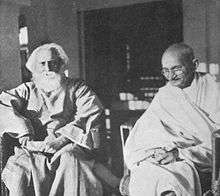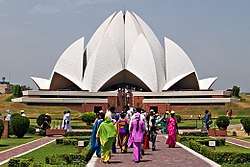Bahá'í Faith and Hinduism
| Bahá'í Faith and the unity of religion |
|---|
 |
| Religions |
Hinduism is recognized in the Bahá'í Faith as one of nine known religions and its scriptures are regarded as predicting the coming of Bahá'u'lláh (Kalki avatar[1]). Krishna is included in the succession of Manifestations of God. The authenticity of the Hindu scriptures is seen as uncertain.[2]
Scriptural references
Bahá'u'lláh was familiar with Hinduism, which is clear from a tablet to Mírzá Abu'l-Fadl, the English translation of which is included in the volume Tabernacle of Unity. In this tablet Bahá'u'lláh answered questions about Hinduism and Zoroastrianism by Maneckji Limji Hataria. The subjects include comparative religion, and constitute, while much remains implicit, a dialogue of Bahá'u'lláh with Hinduism and the other religions discussed, giving an understanding of what Baha'u'llah meant with the unity of the world religions.[3]
In another tablet (published in Gleanings, section LXXXVII) Bahá'u'lláh discussed the absence of records about history before Adam. Here he refers to the Jug-Basisht (Book of Juk), which is the Persian translation of the Yoga Vasistha, a syncretic philosophic text.[3] The translation was done during the Mughal Dynasty in the sixteenth century A.D. and became popular in Persia among intellectuals with Indo-Persian interests since then.[4] In the Story of Bhusunda, a chapter of the Yoga Vasistha, a very old sage, Bhusunda, recalls a succession of epochs in the earth's history, as described in Hindu cosmology. Juan Cole states that this means that in dating Creation, Bahá'u'lláh promotes the theory of a long chronology over a short one.[3]
Teachings
Brahman (God)
In Hinduism Brahman is believed to be the Absolute Reality. Followers of Vedanta see Brahman as an impersonal reality, of which each soul (ātman) is a part. The theistic traditions of Hinduism, which include Vaishnavism and Shaivism, consider Brahman as a personal God, whom they call Bhagwan or Ishvara (Lord).[5] According to the Bahá'í teachings these differing views are all valid, as they represent different points of view looking at the Absolute Reality.[6]
Avatars (Manifestations of God)
Both Hinduism and the Bahá'í Faith teach that God manifests himself at different times and places. These messengers are termed Avatars in Hinduism and Manifestations of God in the Bahá'í teachings.[7] However the difference is that Hinduism teaches that Avatars are God himself in human form and are thus divine while Bahá'í teachings stress that the Manifestations of God are not God but his representatives.
The Manifestations of God are not seen as incarnations of God as God cannot be divided and does not descend to the condition of his creatures, but they are also not seen as ordinary mortals. Instead, the Bahá'í concept of a Manifestation of God emphasizes the simultaneously existing qualities of humanity and divinity. In the station of divinity, they show forth the will, knowledge and attributes of God; in the station of humanity, they show the physical qualities of common man.[8] A common Bahá'í analogy used to explain the relationship between the Manifestation of God and God is that of a perfect mirror. In the analogy, God is likened to the Sun – the source of physical life on earth. The spirit and attributes of God are likened to the rays of the Sun, and the Manifestations of God are likened to perfect mirrors reflecting the rays of the Sun.[9] Thus, the Manifestations of God act as pure mirrors that reflect the attributes of God onto this material world.[8]
Deities and images
In Hinduism many deities, depicted in images and murti (statues), are worshipped. Many Hindus realize that all these deities represent different aspects of the one God, Brahman. The Bahá'í teachings state that in this day, when mankind is reaching the state of maturity, images are not needed anymore to form an idea of God.[10]
Ethical and moral teachings
There are many similarities in the ethical and moral teachings of Hinduism and the Bahá'í Faith. These include subject as contemplation, detachment, faith, love, non-violence, purity, respect for parents, righteousness, self-control, right speech, not stealing, truth, virtue, work as worship.[11]
Adaptation of Bahá'í teachings to Hindu context
The speedy growth of the Indian Bahá'í community since the 1960s was influenced by adapting the Bahá'í teachings for presentation in a clearly Hindu context familiar to the people of the countryside - using principles and language familiar to them:[2][12]
- the presentation of Bahá'u'lláh as the Kalki Avatar who according to the Vishnu Purana will appear at the end of the Kali Yuga for the purpose of reestablishing an era of righteousness;
- emphasizing the figures of Buddha and Krishna as past Manifestations of God or Avatars;
- references to Hindu scriptures such as the Bhagavad Gita;
- the substitution of Sanskrit-based terminology for Arabic and Persian where possible (i.e., Bhagavan Baha for Bahá'u'lláh), and the incorporation in both song (bhajan)[13] and literature of Hindu holy places, hero-figures and poetic images;
- Hindi translations of Baha'i scriptures and prayers that appeared during this period which are so heavily Sanskritized as to make it difficult to recognize their non-Hindu antecedents.
Gandhi and Tagore

Mahatma Gandhi and writer Rabindranath Tagore, both Hindus, had contact with Bahá'ís on several occasions.[14][15] In his book Mahatma Gandhi and the Bahá'ís, M.V. Gandhimohan analyzes similarities and differences between Gandhi's thought and the Bahá'í teachings.[14] Gandhi called the Bahá'í Faith "a solace to humankind".[14]
Tagore met 'Abdu'l-Bahá in Chicago, United States, in 1912, a few months before his Nobel-prize winning collection of poetry Gitanjali was first published in English. 'Abdu'l-Bahá later wrote about Tagore that "he is one of the promoters of peace and reconciliation. He is kind to all people".[15] Tagore, who was also the secretary of the Hindu reform movement Adi Brahmo Samaj, stated that "the ideals of my university (Visva-Bharati) Santiniketan, Bengal, India, are quite akin to the universal ideals of Bahá’u’lláh. Visva-Bharati cherishes the ideal of an active co-operation between the different religions and cultures of the East and the West, and nothing would please me more than to offer a permanent place at my university to the culture and research of the great religion founded by the Prophet Bahá’u’lláh.".[15] On another occasion he stated that Bahá’u’lláh "is the latest Prophet to come out of Asia. His life is certainly a glorious record of unflinching human search after truth; and his message is of great importance for the progress of civilization."[15]
See also
Notes
- ↑ Buck, Christopher (1986). A Unique Eschatological Interface: Baha'u'llah and Cross-Cultural Messianism, published in: In Iran: Studies in Babi and Baha'i History vol. 3, ed. Peter Smith, pp. 157-179. Kalimat Press, Los Angeles.
- 1 2 Smith, Peter (2000). "Indian religions". A concise encyclopedia of the Bahá'í Faith. Oxford: Oneworld Publications. p. 195. ISBN 1-85168-184-1.
- 1 2 3 Cole, Juan R. I. Baha'u'llah on Hinduism and Zoroastrianism: The Tablet to Mirza Abu'l-Fadl Concerning the Questions of Manakji Limji Hataria.
- ↑ Cole, Juan R.I. "Iranian Culture and South Asia, 1500-1900". in: Keddie, Nikki (ed.). (2002). Iran and the Surrounding World: Interactions in Culture and Cultural Politics. pp. 22-23
- ↑ Momen 1990, pp. ix
- ↑ Momen 1990, pp. 1–5
- ↑ Momen 1990, pp. 5–9
- 1 2 Cole, Juan (1982). "The Concept of Manifestation in the Bahá'í Writings". Bahá'í Studies. monograph 9: 1–38.
- ↑ Hatcher, W.S.; Martin, J.D. (1998). The Bahá'í Faith: The Emerging Global Religion. San Francisco: Harper & Row. p. 118. ISBN 0-87743-264-3.
- ↑ Momen 1990, pp. 11–12
- ↑ Momen 1990, pp. 13–21
- ↑ Garlington, William. The Baha'i Faith in India: A Developmental Stage Approach, Occasional Papers in Shaykhi, Babi and Baha'i Studies, No. 2 (June, 1997).
- ↑ Garlington, William. The Baha'i Bhajans: An example of the Baha'i Use of Hindu Symbols, Occasional Papers in Shaykhi, Babi and Baha'i Studies, Vol. 2, No. 1 (January, 1998).
- 1 2 3 Gandhimohan, M.V. (2000). Mahatma Gandhi and the Bahá'ís. New Delhi, India: Bahá'í Publishing Trust. pp. 14–15. ISBN 81-86953-82-5.
- 1 2 3 4 Terry, Peter (1992, 2015) Rabindranath Tagore: Some Encounters with Bahá'ís.
References
- Momen, Moojan (1990). Hinduism and the Bahá'í Faith. Oxford, UK: George Ronald. ISBN 0-85398-299-6.
Further reading
- Khursheed, Anjam (1997). The Hindu Concept of God: Unity in Diversity, in Singapore Bahá'í Studies Review, vol. 2, pp. 3-49.
- Merchant, A.K. (2005). The Concept of Atman (Human Soul) in Vedic & Bahá’í Scriptures.
- Buck, Christopher (1980). The Mystery of the Sworded Warrior in Hindu Apocalypse: Was Kalki Visnuyas Bahá'u'lláh?.
- Gandhimohan, M.V. (2000). Mahatma Gandhi and the Bahá'ís. New Delhi, India: Bahá'í Publishing Trust. ISBN 81-86953-82-5.
- Munje, Dr. H.M. (1997). The Reincarnation Mystery Revealed. New Delhi, India: Bahá'í Publishing Trust. ISBN 81-86953-02-7.
- Sarwal, Anil (1996). Miracles in Religion. Bahá'í Publishing Trust, New Delhi, India.
- Sarwal, Anil (2001). Sri Aurobindo Movement and the Bahá'í Faith.
- Sours, Michael (2000). "Hindu and Buddhist Scripture in Bahá'í Scripture". Without Syllable or Sound: The World's Sacred Scriptures in the Bahá'í Faith. Los Angeles, United States: Kalimat Press. ISBN 1-890688-06-1.
- Related documents on Bahá'í Library Online
External links
- 'Abdu'l-Bahá and Shoghi Effendi. Buddha, Krishna, Zoroaster and Related Subjects, compiled by Research Department of the Universal House of Justice.
- Memorandum and compilation on reincarnation, rebirth and the progress of the soul (25 April 1995)
- Prophecy Fulfilled: Hindu Prophecies
- BahaiPrayers.net - Bahá'í prayers in several Indian languages
- Bahá'í Songs in Indian Languages
